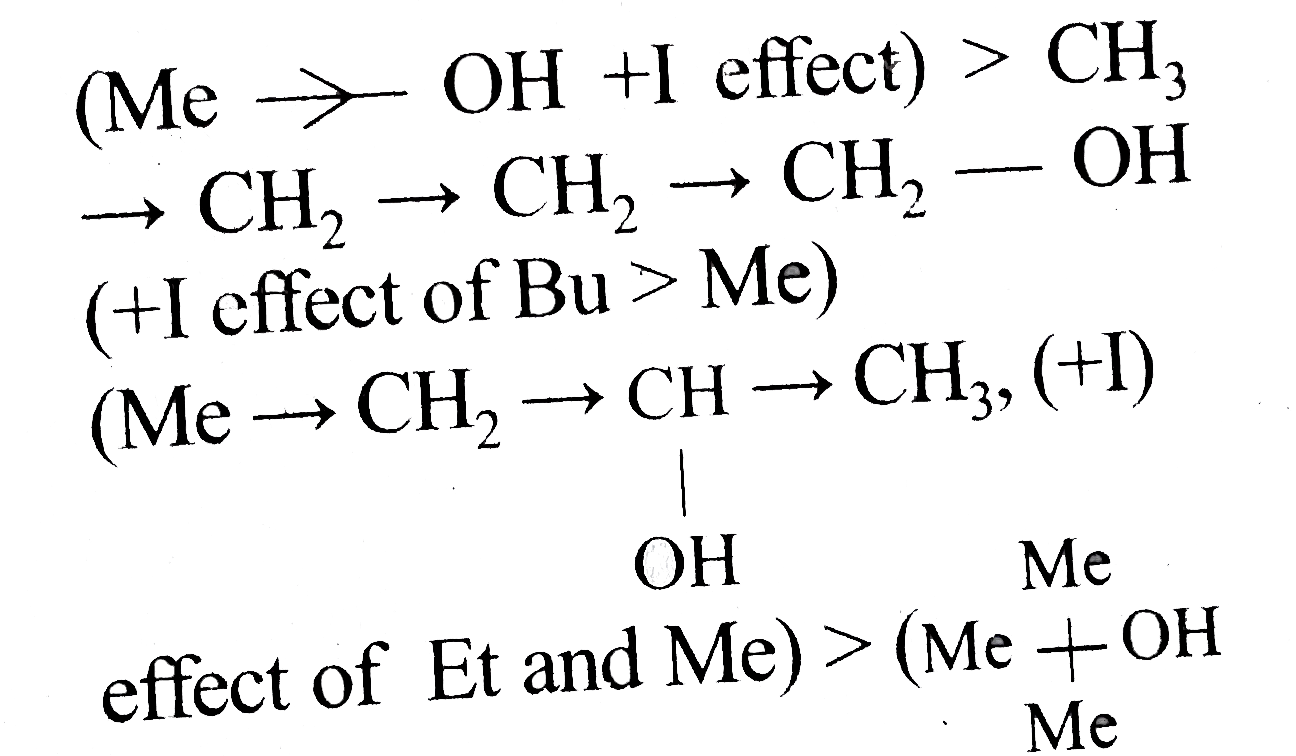Arrange the following in the decreasing order of acidity :
(i) (1) n−Butanol
(2) Methy1 alcohol
(3) sec-Butanol
(4) rert-Butanol
(ii) (1) HCOOH
(2) CH3COOH
(3) C2H5COOH
(4) C6H5COOH
(5) (CH3)2CHCOOH
(6) CH2C1COOH
(iii) (1) CH3CH2CH2COOH
(2) CH3CH2CHC1COOH
(3) CH3CHC1CH2COOH
(4) CH2C1CH2CH2COOH
(iv) (1) CH3COOH
(2) CH2C1COOH
(3) CHC12COOH
(4) CC13COOH
(v) (1) CH3BrCOOH
(2) CH2C1COOH
(3) CH2FCOOH
(4) CH2ICOOH
(vi) (1) C6H5COOH
(2) p−OHC6H4COOH
(3) p−CH3C6H4COOH
(4) p−C1C6H4COOH
(5) p−BrC6H4COOH
(6) p−BO2C6H4COOH
(vii) (1) o-Hydroxybenzoic acid
(2) p-Hydroxybenzoic acid
(3) 2,6−Dihydroxybenzoic acid.
(viii) (1) HCOOH
(2) C6H5COOH
(3) C6H5OH
(4) HC1
(ix) RCOOH
(2) ROH
(3) RH
(4) NH3
(5) HOH
(6) CH≡CH
(x) (1) Phenol
(2) p-Chlorophenol
(3) p-Nitrophenol
(4) m-Cresol
(xi) (1) Phenol
(2) m-Chlorophenol
(3) m-Nitrophenol
(4) m-Cresol
(xii) (1) Phenol
(2) Benzoic acid
(3) p-Nitrophenol
(4) Carbonic acid
(xiii) (1) Phenol
(2) Benzyl alcohol
(3) Benzene sulphonic acid
(4) Benzoic acid
(xiv) (1) Phenol
(2) p-Chlorophenol
(3) 2,4,-Dichlorophenol
(4) 2,4,6-Trichlorophenol
(xv) (1) Nitroform HC(NO2)3
(2) Cyanoform HC(CN)3
(3) CHC13
(xvi) (1) CH3SO2CH3
(2) CH3NO2
(xvii) (1) CH3BO−OӨ
(2) CH3CHO
(3) CH3COOR.
(i) 
(ii) 6>1>4>2>3>5 (In (6)−I effect of C1>(1) (standard) >(4)+R>−I of Ph>(2)+Ieffect of Me>(3)+I effect of Et>(5)+I effect of two Me groups) .
(iii) 2>3>4>1 (2) −I effect of C1 at α−C>(3)−I effect of C1 at β−C>(4)−I effect of C1 at γ−C>(1)+I effect of CH3CH2CH2.
(iv) 4>3>2>1 (4) −I effect of 3C1 at α−C> (2) −I effect of 1C1 at α−C>(1)+I effect of (CH3−) group
(v) 3>2>1>4 (3) −I effect of F=(2)−I effect of C1>(1)−I effect of Br>(4)−I effect of I
(vi) 6>4>5>1>3>2 (6) −1 and −R effect of (−NO2) group >(4)−I effect of C1>(5)−I effect of Br>(1) standard >(3)+I and H.C effect of CH3−atp−>
(2) −I and −R effect of OH group at p− However, the net effect is more ¯e−donating than the net effect of (3), since +R>+I and H.C effects.
(vii) 3>1>2 (3) Intramolecular H-bonding from two sides >(I) Intramolecular H-bonding from one sides >(2)−I and +R effects of OH group at p−position , net effect is ¯e−donating.
(viii) 4>1>2>3 (4) Inorganic acid >(1) Formic acid (standard) >(2) Benzonic acid, −I and +R of Ph group, net ¯e−donating >(3) Phenol.
(ix) 1>5>2>6>4>3> (I) Acid >(5)H2O>(2) Alcohol >(6)HC≡CH
(sp character) >(4)nH3>(3) Alkane (sp3 character)
(x) 3>2>1>4 (3) −NO2(−I and −R effects of C1 at p−)>(2)−C1−I effects of C1 at p−>(1) Standard (phenol) >(4)CH3+I effected of CH3 at m−position.
(xi) 3>2>1>4 (3) (−NO2) (only −I effect of (−NO2) at m−)>(2)−C1(−I effected of C1 at m−)>(1) Standard (phenol) gt
(4)Ch3 (only +1 effect of CH3 at m−position.
(xi) 2>4>3>1 (2) Benzoic acid >(4) Weak inorganic acid >(3) Nitro phenol (−NO2)(−I and −R effect of (−NO2) at p−)>(1) phenol.
(xiii) 3>4>1>2 (3) Sulphonic acid, −I and −R effects of (−SO3H) group >(4), Benzoic acid, −I and −R effects of (−COOH) group, but (−SO3H) effect >(−COOH) effect >(1)Phenol >(2) Alcohol)
(xiv) 4>3>2>1 (4) −I effect of 3C1>(3)−I effect of 2C1>(2)−I effect of 1C1>(1) Phenol, standard
(xv) 1>2>3 (1) −I effect of three NO2 groups >(2)−I effects of three CN groups >(3)−I effect of three C1 groups , −I effect of : −NO2>−CN>−C1.
(xvi) 2>1(2)−NO2(−I effect of NO2)>(1)−I effect SO2 and +I effect of two CH3 groups.
(xvii) 1>2>3 (1) −I effect of −NO2>(2)−I effect of −CHO>(3)−I effect of (−COOR) group) , −I effect of : −NO2>−CHO>−COOR.
Topper's Solved these Questions
- GENERAL ORGANIC CHEMISTRYBOOK - CENGAGE CHEMISTRYCHAPTER - GENERAL ORGANIC CHEMISTRYEXERCISE - Subjective
11 Videos
- GENERAL ORGANIC CHEMISTRYBOOK - CENGAGE CHEMISTRYCHAPTER - GENERAL ORGANIC CHEMISTRYEXERCISE - Concept
16 Videos
- GENERAL ORGANIC CHEMISTRYBOOK - CENGAGE CHEMISTRYCHAPTER - GENERAL ORGANIC CHEMISTRYEXERCISE - Analytical and Descriptive
1 Videos
- CLASSIFICATION AND NOMENCLATURE OF ORGANIC COMPOUNDSBOOK - CENGAGE CHEMISTRYCHAPTER - CLASSIFICATION AND NOMENCLATURE OF ORGANIC COMPOUNDSEXERCISE - Analytical and Descriptive Type
3 Videos
- HYDROGEN, WATER AND HYDROGEN PEROXIDEBOOK - CENGAGE CHEMISTRYCHAPTER - HYDROGEN, WATER AND HYDROGEN PEROXIDEEXERCISE - Subjective Archive (Subjective)
3 Videos
Similar Questions
Arrange the following in the increasing order of acidic strength :
(i) ClCH2COOH
(ii) CH2ClCH2COOH
(iii ) FCH2COOH
(iv) CH3COOH
View SolutionWrite the IUPAC names of the following :
(i)CH3CH=CHCOOH (ii)CH3CH2CH2COOH (iii)C6H5CH2COOH (iv)(CH3)3CCOOH (v)CH3CH2COCH2COOH(vi)(CH3)3CCH2COOH <br> (vii)CH3−C∣OHH−CH2COOH
View Solution
Knowledge Check
Place the following in the correct order of acidity
1. CH≡ C COOH 2. CH2≡CHCOOH
3. CH3CH2COOHA1>2>3B3>2>1C2>1>3D1>2>2Arrange the following compounds in decreasing order of acidity.
(i) ClCH2CH2CH2COOH
(ii) CH3CHClCH2COOH
(iii) CH3CH2CHClCOOHAI>II>IIIBIII>II>ICI>III>IIDIII>I>II
Arrange the following illustration in order of increasing acidity :
(i) HCOOH, ClCH2COOH, CH3COOH
(ii) CH3COOH, (CH3)2CHOOH , (CH3)3CCOOH
(iii) ClCH2COOH, Cl2CHOOH, CH3COOH .
(iv) ClCH2COOH, CH3CH2COOH ,ClCH2CH2COOH,(CH3)2 CHOCOOH, CH3COOH
(V) CH3COOH, Cl2CHCOOH, CH3CH2COOH,Cl2CCOOH, ClCH2COOH.
View SolutionWhich of the following is a stronger acid in each of the following pairs ?
(a) CH2(Cl)COOH,CH2(F)COOH (b)CH2(Cl)CH2CH2COOH,CH3COOH,CH3CH(Cl)CH2COOH
(c ) CH3COOH,C6H5CH2COOH (d)m−NO2C6H4COOH,p−NO2C6H4COOH
(e)p−NO2C6H4COOH,C6H5COOH (f)m−OHC6H4COOH,p−OHC6H4COOH
View SolutionArrange the following in the decresing order of acidic strength :
(a) H2O,CH3OH,C6H5,OH,CH2COOH
(b)CH3CH2COOH,HOCH,C6H5COOH,ClCH2COOH
View SolutionGive the decreasing order of acidic character.
(a) NO2CH2OH,
(b) C1CH2COOH,
(c) HCOOH,
(d) CH3COOH,
( e) CH3OH
View SolutionArrange the following compounds in decreasing order of acidity.
(i) ClCH2CH2CH2COOH
(ii) CH3CHClCH2COOH
(iii) CH3CH2CHClCOOH
View SolutionArrange the following as stated :
'Increasing order of acidic strength'.
ClCH2COOH,CH3CH2COOH,ClCH2CH2COOH,(CH3)2CHCOOH,CH3COOH.
View Solution
